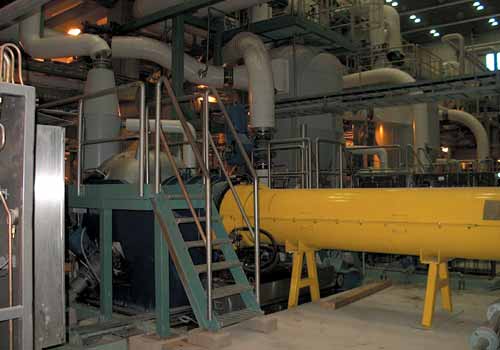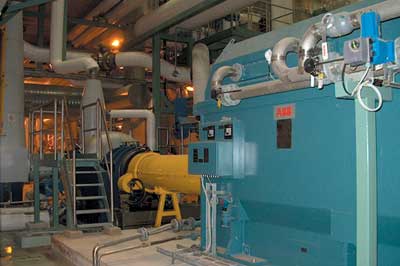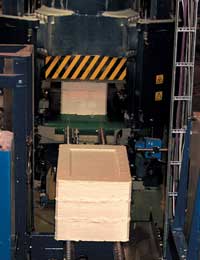BCTMP from Joutseno: it is Real good
by Graeme Rodden,
Editor
Moving beyond commodities, this greenfield pulp mill was designed to supply M-real's paper mills, especially Kangas' coated paper machines
Skyrocketing to number nine among world papermakers, M-real has accomplished this not only through mergers and acquisitions, but also by internal growth. Its most recent project was the completion of a 210,000 tonne/yr greenfield bleached chemi-thermomechanical pulp (BCTMP) mill in Joutseno, Finland. Adjacent to Metsä-Botnia's kraft pulp mill, M-real's mill is one of a handful producing BCTMP in Finland.
Using an aspen furnish, the pulp is destined for a variety of end uses. (Some grades use spruce, but this makes up no more than 10% of the mill's wood consumption.) However, the raison d'être for building a BCTMP mill was the conversion of M-real's PM 4 at the Kangas mill in Finland from uncoated to coated paper grades. BCTMP provides good bulk, needed for Kangas' coated paper. M-real spent Euro 220 million on the two projects, about half on each.
Why build at Joutseno? A new fiber line had been installed at the adjacent kraft pulp mill (the subject of an upcoming PPI feature) and M-real could take advantage of the project organization that was still in place. The BCTMP mill could be integrated with the kraft mill on basic raw materials such as water. Other facilities could also shared (which will be explained later in the article). New kraft mills tend to produce more energy than they can use, another reason why Joutseno was M-real's preferred site. Finally, the mill is situated close to the Russian border, which makes log transportation into the mill cheaper.
The BCTMP project was done on a "fast track" basis. The mill started up in August 2001 although equipment orders were only placed in spring 2000. Although Metsä-Botnia used Jaakko Pöyry as its consultant, M-real went with PI, also Finnish based.
Together, Kangas' two paper machines, PM 2 and PM 4 will consume about 40% of Joutseno's pulp. PM 2 was converted to coated paper production in December 2001. Other users include M-real's PM 8 at the Husum mill in Sweden. It started lightweight coated (LWC) production with Canadian pulp in March 2001, but has since switched over to Joutseno's BCTMP. It is the mill's second biggest customer.
 |

Production manager Marko Pekkola has good reason to smile with the mill’s successful startup |
Besides being the right pulp for LWC, BCTMP has properties (high freeness, high bulk) that board makers also find attractive. Joutseno's production manager, Marko Pekkola, says that three smaller board machines and one large one (at M-real's Aänekoski mill) have started using Joutseno's pulp. Aänekoski's board machine is in the middle of a rebuild scheduled to be complete by September 2002 that will see it switch from spruce groundwood pulp to BCTMP. "They have done trials and have worked out deals with customers." The bulk of Joutseno's pulp is going to board and LWC mills.
M-real had experience with aspen as a furnish for high end paper grades at its Kirkniemi mill. "Market feedback was good," says Pekkola. "That is one reason why Kangas was converted to coated from uncoated paper."
Pekkola says the pulp can be divided into three end uses: LWC, fine paper and board. Within each of the three categories, there can be variations in properties depending on end use requirements. The main difference between the three is in the freeness level. Joutseno can produce pulp in the range of 120 to 450 ml Canadian Standard Freeness (CSF). Low freeness grades which combine good light scattering properties, high bulk, and good smoothness are rare on the market because conventional BCTMP mills are designed to produce low energy, high freeness hardwood kraft replacement pulps.
The design of the mill also reflects the importance to produce high opacity, bulky, high bright mechanical pulps to capitalize on these features for graphic papers.
Besides the improved bulk, Pekkola adds that aspen BCTMP will give better printability because the paper surface will not be rough. Formation will also improve. There are also economics to consider. BCTMP is much cheaper as a furnish than kraft pulp and yields are better.
All of Joutseno's BCTMP is destined for M-real's own mills. There are no plans at present to sell the pulp on the market. The production budget for 2002 is 180,000 tonnes. The mill aims to reach its full design capacity of 210,000 tonnes/yr in 2003. So far, "Things are going well," Pekkola says.
Aspen logs and spruce chips
The mill uses about 750 000 m3/yr of aspen, 20% of which arrives by water (Lake Saimaa). The rest arrives by truck or train. All of the aspen used is roundwood, 30% from Finland, 70% from Russia and other Baltic countries. Upon arrival, a laser measuring system determines the size of the load.
The spruce arrives in chip form from one of Metsäliitto's sawmills. Metsäliitto is a part owner of M-real (Box 1).

Joutseno’s new equipment includes chip receiving/washing and impregnation systems, as well as dewatering presses |
The aspen logs are debarked in one of two new debarking lines at the adjacent Metsä-Botnia kraft pulp mill. This is but one of the many examples of the integration between the mills.
For chip storage, BMH supplied three silos, two for aspen, one for spruce, with a capacity of 4,000 m3 each.
Despite the newness of the equipment, Pekkola said it would be fair to call the mill's mechanical pulping process "standard". Andritz supplied the bulk of the entire fiber line. This includes the woodyard, including the two debarking lines, Andritz PowerFeed deicing conveyors and HHQ-Chippers with horizontal feed. The feed is designed to provide uniform chip quality and high capacity.
With a capacity of 1,200 tonnes/day, the chip washer is Andritz' largest installation. It includes six Hydrasieve washers, a 140 m3 trash separator, a wash water tank and triple dewatering screw. Washed chips are distributed to one of two parallel impregnation lines using the Andritz RT process, which features pressurized steaming for a short, precisely controlled period prior to heavy compaction and maceration in one of two chip presses with special turbo feeders. Thermal pretreatment applies high compression forces without damaging the fibers.
The chips then pass to one of two vertical twin screw impregnators. These ensure accurate chemical take-up for bleaching. They also soften the chips and expose secondary fiber walls for improved refining. Joutseno uses sodium sulfite, caustic and diethylenetriaminepentaacetic acid (DTPA) as its impregnation chemicals.
There are two stages in each of the refining lines, primary and secondary. Metso Paper supplied the four CD-82 refiners. They are powered by ABB motors, 20 MW in the first stage, 15 MW in the second.
After dilution and latency removal, the refined pulp is pumped to a two-stage screening system, supplied by Andritz-Ahlstrom. The accepts are dewatered on two Andritz disc filters to take care of the difference in freeness levels. Screened rejects are rescreened and concentrated rejects are sent to two parallel high consistency RGP 68 reject refiners from Metso Paper. ABB also supplied the motors for these refiners, 10 MW each.

One of the primary CD-82 refiners. Each is powered by a 20 MW motor |
The Andritz two-stage high consistency bleaching system brings pulp to 80-85 ISO brightness. At present, Kemira supplies the hydrogen peroxide used as the bleaching agent. The system is designed to have low chemical oxygen demand (COD) carryover and anionic trash levels. The twin wire and screw presses allow high consistencies. The screw presses are before the first bleaching stage and after the second. The twin wire presses are located after the first bleaching stage and before drying. The system is designed to keep bleaching costs at a minimum.
Prior to drying, the pulp is fluffed in one of two Andritz HC-Fluffers. These are designed for maximum fluffing efficiency, to allow maximum energy savings in the dryers. ABB supplied the two flash drying lines. They use natural gas as fuel.
When baled, the pulp is 88-90 bone dry, depending on the grade and customer preference. Metso Paper supplied the baling line. The bales leave the mill by rail or truck.
Through the process, the mill uses a Metso PulpExpert system for measuring fines, shives and fiber length. Metso Automation supplied the mill's process control system. It controls the entire process except for the baling line, which has a Siemens' Simatic system.
M-real does not treat its pulp in any special way during the process, for example, fractionation. This is a possibility for the future. The main issue, Pekkola says, is the investment. It can be high and the mill has to justify the benefits it would receive versus the cost.
A small footprint
| M-real, Metsäliitto and Metsä-Botnia |
M-real has quadrupled its turnover over the past five years, focusing on coated and uncoated fine papers as well as packaging boards. Recent acquisitions include Modo Paper of Sweden and Zanders of Germany.
It now makes 6.1 million tonnes/yr of paper and board. M-real's main shareholder is Metsäliitto, a Finnish forest owners' cooperative. M-real owns about 24% of the stock of Metsä-Botnia, which is also owned by UPM-Kymmene (47%) and Metsäliitto. |
|
On the effluent treatment side, Joutseno BCTMP installed a Rinheat evaporation system that includes a six-effect falling film series. Steam generated during refining is used to produce clean steam in a reboiler that serves as the energy source for the evaporation plant. Rinheat also supplied the heat recovery system.
Instead of sending the recovered COD to the effluent treatment plant, it is pumped to the Metsä-Botnia kraft pulp mill. "We sell them the concentrate from the evaporators," Pekkola adds. "They use the chemicals."
Only a little bit of effluent from the evaporators goes to the treatment plant. Water is re-used in the BCTMP mill. The mill's wastewater level is exceptionally low, 2 m3/tonne. Metsä-Botnia is in charge of the effluent treatment plant. Costs are divided according to the amounts of water, COD and biological oxygen demand (BOD) each mill sends for treatment.
Minimal manpower
Although it is designed to produce 210,000 tonnes/yr, the mill employs just 43 people. Eight are staff, 35 are shift workers. There are five shifts with seven workers each. One principle the mill followed for its shifts is that all workers have a basic education in mechanical, automation and electrical processes.
Of the 35 people, about 17 came from within the M-real organization. The others had no previous pulp and paper experience. They all went through a seven-month training period that included a stint at a Canadian BCTMP mill.

Baled pulp is 88-90 bone dry |
 |
Shift workers do preventive maintenance as well as other maintenance tasks, but if the workload becomes too high, the work is outsourced. "But we do what we can on our own," Pekkola comments. Regular daily maintenance is outsourced to Botnia Mill Services, a company formed in 1999 by a group of mechanical, automati on and electrical supervisors who had worked for Metsä-Botnia.
There are two big shutdowns per year: mid-summer for three days and Christmas for 2.5 days. If markets dictate, downtime is taken and maintenance work is also carried out then. Pulp storage capacity is 1.5 weeks. The mill may also opt to take one refining line down for maintenance while continuing to operate the other.
This is the first integration of a BCTMP mill with a kraft pulp mill and Pekkola thinks it may be a trend that the industry will see more frequently. Numerous benefits are claimed: improved efficiency, economy of scale and improved logistics.
The efficiency gains come from improved wood use, combined effluent/concentrate combustion, chemical recovery and power generation. The economy of scale is relevant in areas such as wood processing, effluent treatment and distribution. The improved logistics can be seen in procurement, transportation, administration and marketing.
But does all of this work? Apparently so. Pekkola says that quality is better than expected and as time goes on, should improve further. More importantly, customers are happy with the product they receive.
|